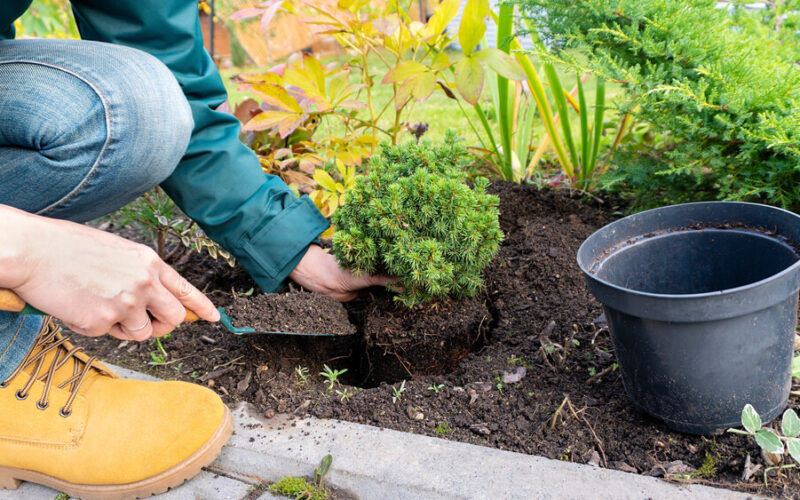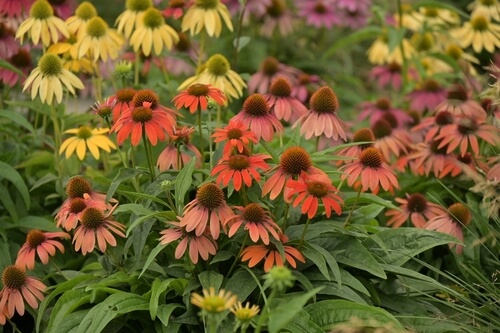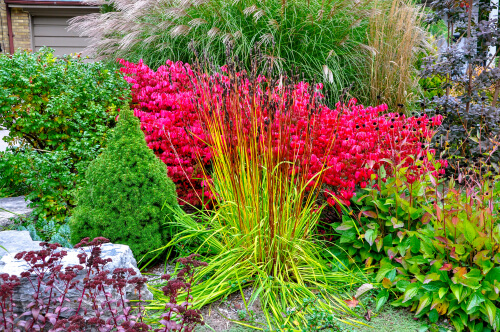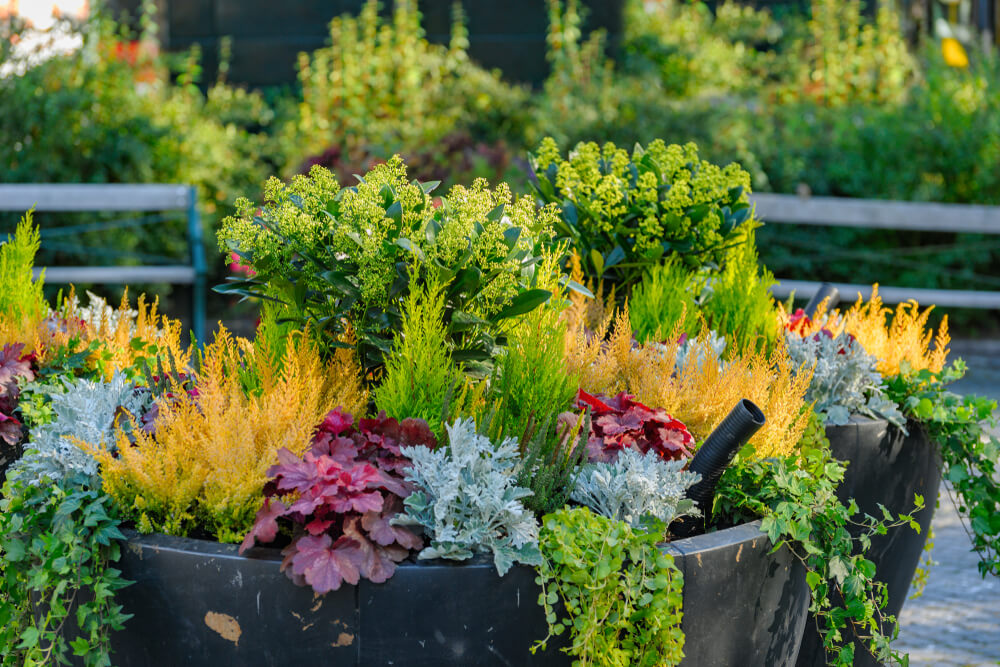Fall Planting Tips & Ideas for a Successful Autumn

Autumn is for beautiful leaves, cozy sweaters, pumpkin everything, and our personal favorite… gardening. It’s not time to pack up your work gloves and fertilizer just yet. Today we’re sharing our tips and ideas for a successful fall planting season.
Benefits of Fall Planting
With the new season comes cooler temperatures, shorter days, and (hopefully) a thriving garden! Many people think of spring and summer as prime planting time, but growing in autumn has many benefits.
The colder temperatures are easier on you and your plants. When autumn comes around, there is less concern about diseases, pests, and weeds. And as the days get shorter and evaporation decreases, your garden doesn’t require as much moisture to get the nutrients it needs. This means less work for you and less stress for your plants!
Fall planting is also great for root establishment. During this season, some plants enter their dormant phase, where they focus their energy on strengthening their roots rather than producing new foliage. By planting now, you’re extending the growing season, building stronger roots, and helping your plants withstand the harsh temperatures and droughts of Pennsylvania summers.
Fall Planting Tips Everyone Should Know
Preparing your plants for winter can be tricky, especially in central PA. That’s what makes fall gardening unique, and we’re here to share our best tips for a successful autumn season.
1. Prepare Your Soil
Autumn is an ideal time to prep your soil because it’s still warm and easy to work with. Always till the dirt and remove any weeds, rocks, or diseased plants. Clear out your summer annuals and bring in any bulbs or cuttings you want inside for the winter.
The next step is adding organic matter, like compost (for vegetable gardens) or mulch (for flowers and shrubs). This helps protect your plants from frost, changing temperatures, and moisture loss. Just add a few inches and mix it evenly with the top layer of soil.
2. Time Your Garden
Knowing when to plant a garden is so crucial for a successful autumn. Begin prepping in late summer, and always get your plants in the ground at least six weeks before the first frost of the season. For most regions, early November is your last chance. Remember, you won’t see much new growth in the fall and that’s ok! Plants are focusing on root development during this time.
3. Fertilize Away
Autumn is also a great time to fertilize. Adding slow-release fertilizer in the late summer and early fall will help your plants grow stronger roots to get them through winter. Understand your bag of fertilizer with this quick guide:
- Nitrogen (N): encourages upward growth of foliage
- Phosphorus (P): stimulates downward growth of roots
- Potassium (K): promotes all-around plant health and cell function
Each type of plant has different fertilizer needs. For example, perennials need high-phosphate fertilizer with low nitrogen. Spring flowering bulbs require phosphorus applied at the root when you’re planting. Trees and shrubs thrive with slow-release fertilizers in the fall, and roses don’t need any fertilizer at all!

4. Protect Plants From Frost
With harsh winters on the horizon, you need to make sure your plants are prepared. Not all of them will need protection, but saplings and young plants are more vulnerable to changing temperatures. Mulching helps, but there are other steps you can take to ensure your plants survive the cold.
The first (and easiest) step is moving containers indoors. For large outdoor plants and garden beds, consider covering them with a frost cloth or another breathable fabric. Smaller plants can be protected with translucent covers called cloches.
At the end of the day, the best fall gardening tip we can offer is to choose hardy plants that can handle the cold Pennsylvania winters.
5. Adjust Your Watering Schedule
As we mentioned above, autumn plants typically don’t need as much water. Feeding them once a week should be enough, but it depends on the weather. If it’s been uncharacteristically hot and dry, then they may need more. And if there’s been excessive rainstorms, you may want to cut back.
Time your watering right before an oncoming frost. The wet soil absorbs heat and acts as insulation for your plants, increasing the temperature around your plant by several degrees! This is another method to protect your plants from frost.
6. Practice Fall Plant Care
It’s not just about planting an autumn garden, but knowing how to care for one. Follow our tips for fall pruning to ensure your plants thrive all year long. Make sure to wait until after dormancy has set in. Monitor for overwintering pests and take precautions to insulate your plants’ roots.
Choosing the Best Fall Plants
Now to the fun part of fall planting—choosing what will go in your garden. The best fall plants are hardy and vibrant. Add pops of color to your yard with some of our favorite flowers, vegetables, and trees that thrive in autumn.
Fall Blooming Perennials
- Coneflowers
- Black-Eyed Susans
- Asters
- Goldenrod
- Sedums
- Japenese Anemones
Shrubs and Trees
- Burning Bush
- Holly
- Crape Myrtles
- Beauty Berry
- Cypress
- Butterfly Bush
- With Adler
Vegetables
- Beets
- Cabbage
- Broccoli
- Spinach
- Beans
- Carrots
- Onions
Herbs
- Parsley
- Sage
- Thyme
- Rosemary
- Chives
- Mint
- Cilantro
- Lavender
Fall Gardening Ideas
Now that you know the best fall plants to add to your garden, it’s time to dive into our favorite ideas to make the most of your outdoor space.
Embrace Fall Colors
Pair fall foliage and ornamental grasses with late-blooming perennials for a colorful autumn garden. Some of our favorites are coneflowers, marigolds, celosia, mums, forsythia, and burning bush. Another way to incorporate autumn colors is with your containers. Choose planters in warm tones like terracotta or deep red to embrace the season.
Get Creative With Landscaping
For a full and vibrant fall landscape, remember not to deadhead too quickly—you want your flowers to retain their seed pods over winter for propagation and food for wildlife. Plus, they often add a decorative touch to your garden!
For other fall landscaping ideas, consider adding stone paths through your yard, bird feeders and birdbaths, or even small water features! If you want something functional, create a compost pile. Lastly, you can add decorative accents like a garden arbor or landscaping arch.
Design a Container Garden
One of our favorite ways to experiment with fall planting is through container gardens. Start with a creative planter. You can use wicker baskets, barrels, or even pumpkins and gourds for a festive autumn look. And make sure you design a well-balanced arrangement by adding thriller, filler, and spiller plants.
Add Seasonal Decor
No fall gardening list would be complete without autumn decorations. Add string lights and lanterns around your yard for some mood lighting. Gourds and pumpkins don’t just make good planters—they are also perfect doorstep decor! Incorporate hay bales, scarecrows, decorative corn shock, and mums to your garden or front porch for the full autumn experience.
Stay Warm
Our last fall landscaping idea is to upgrade your patio or outdoor hangout space. Lounge around a fire pit in our durable (and comfortable) outdoor furniture sets. Keep it cozy with some autumn-themed throw pillows and blankets, so you can enjoy the fresh air and your beautiful fall landscaping in comfort and style.
Ready to build your fall garden? Check out our selection of plants, containers, and outdoor living essentials to get started.





